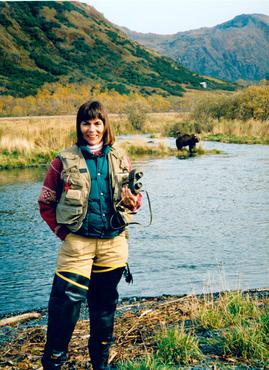
Happy Holidays!
It is the most wonderful time of year! Bears are readying for hibernation, leaves are decomposing, the squirrels and bees have already built up a hoard of resources, and humans are prepping for the holidays! While it might not seem at first glance like anything has changed, one look at my August photo album makes me feel as though an entire lifetime has gone by. For some organisms, an entire lifetime has gone by!
The air smells differently. It is smokey with a bite that tells of approaching cold weather. It was so windy when I went out that it felt much colder than 16 degrees celsius. The last remaining leaves struggled to hold on as the wind tore at them. Birds in the distance chatter incessantly in protest. The changing of the seasons is noticeable in the improved air quality. Southern Ohio is a valley and in the summer the warm temperature causes the polluted air to settle over us. Asthma and allergies are worse at this time of year.
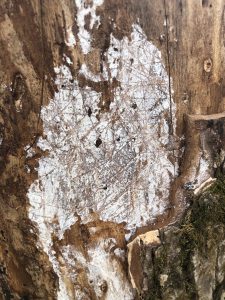
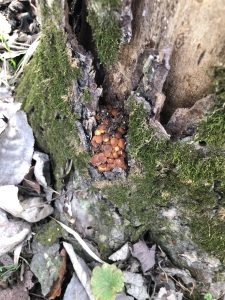
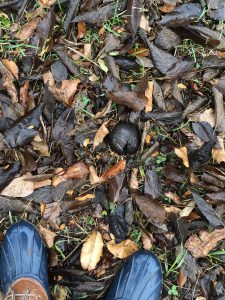
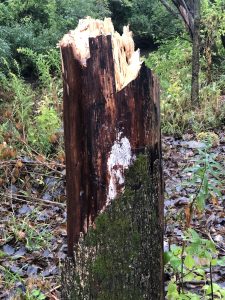
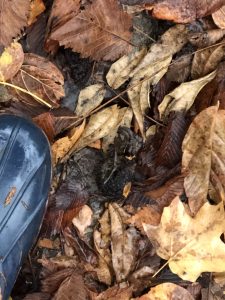
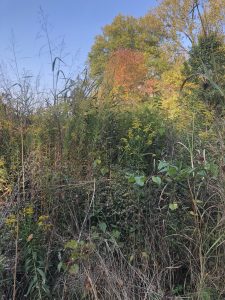
The walnuts I have been watching are far into their period of rot. The outer fruit is gone and only the woody nut remains mostly stamped into the ground and covered by decaying leaves and other organic matter that will help it grow in the spring. The goldenrod has long disappeared due to the influence of man. I wonder how this has impacted the bee population that depends on late season bloom such as this one. My lovely stump is as stalwart as ever providing home to fungi, moss, and a few bugs. The fungus does look a bit dry… interesting.
I did take a moment to check on the creek once more. Throughout the semester, I did notice changes in elevation and speed of the water in relation to precipitation. However, I failed to follow through with a proper spread of water tests. There is always next year I suppose! This is definitely something I wish I had followed more closely.
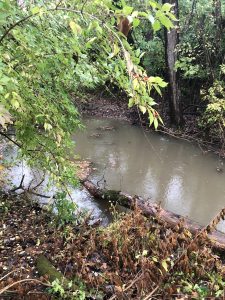
Ms. Arachnid
When stumbling away from the creek, I braced my hand on the trunk of a maple tree and almost died of fright. There was a spider far too close to my hand for my liking! For years I have had a terrible aversion to spiders and for years I have tried to treat that aversion with knowledge. This tactic failed me since I soon found out how many dangerous species there are. Regardless, I stood there tense shouldered and itching and watched it watch me.
While in the field, I decided the spider looked like a Daddy Long-Legs because of its small round body and long legs. It was barely moving or reacting to anything. At one point, a couple of small bugs skittered past and it didn’t even move. I had begun to believe it was dead but when I went to move a leg with a stick it moved (if only minutely) and I decided not to bother him again. Mr. Spider did not seem to have a web and I could not recall whether spiders like this had nests in the ground where they dragged unsuspecting prey in.
![IMG_3615[1]](https://ecologyblog.press.hollins.edu/wp-content/uploads/sites/43/2020/11/IMG_36151-225x300.jpg)
![IMG_3616[1]](https://ecologyblog.press.hollins.edu/wp-content/uploads/sites/43/2020/11/IMG_36161-225x300.jpg)
![IMG_3615[1]](https://ecologyblog.press.hollins.edu/wp-content/uploads/sites/43/2020/11/IMG_36151-1-225x300.jpg)
When I made it to the safety and comfort of my (hopefully) spider free home, I did my research and found it was likely a type of Sclerosmatid Harvestmen known as Leiobunum aldrichi. I had no idea what that was, but I do now. The Leiobunum aldrichi (Daddy Long-Legs) is actually not a spider, but an arachnid of the Opiliones (harvestmen).
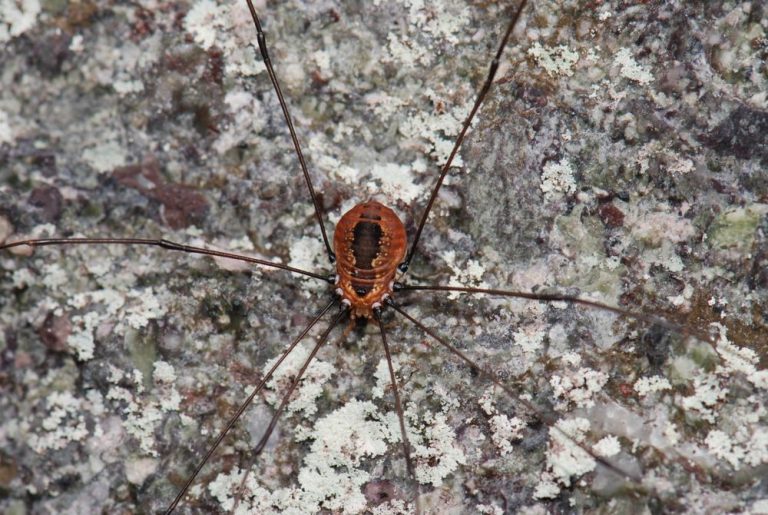
The one I saw was likely a female. She had darker brown colouring rather than orange with some minimal marking. She was also alone. Males of this species tend to group together and, when in the presence of a female, tend to harass her. That is not very gentlemanly! Even more interesting, the sex ratio is biased towards the males in this species. This arachnid is found on trees and logs in deciduous forest across a plethora of states but most widespread in Maryland.
Research on the Leiobunine is relatively scarce. Some new studies have shown some good reasons for taking a closer look at the Harvestmen. In particular, the topic of nuptial gifts varying between species of Leiobunine dependent upon genital structure of males. Species are either sacculate or nonsacculate and this refers to the penial sac surrounding the penis present in those that are sacculate. As a note, the Leiobunum aldrichi is sacculate.
Reproduction for both sacculate and nonsacculate begins the same with a nuptial feeding through endogenous glandular secretions. The male attaches his face to the female and basically provides nutrients like a mother bird would to her young. Then, the male would try to begin penetration. In females mating with sacculate males, they must relax in order to allow the penetration and receive the nuptial gift through the penial sac and exposed papilla. The females mating with nonsacculate males also have certain defenses in place to ward off unwanted advances. However, these females do not receive a nuptial gift.

The gifts are a cocktail of amino acids for both types. Sacculate cocktails have more amino acids and nonsacculate have less. The sacculate conditions and mating style are said to be ancestral. The nonsacculate condition actually evolved twice in two different lines but then converged through evolution to be selective for amino acid cocktails that are specific and consistent.
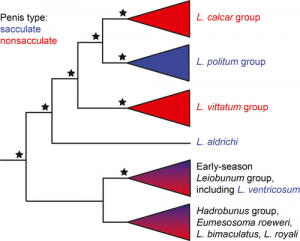
I have two thoughts on this: ew and cool.
Cloudy With a Chance
Clouds are a little less gross. I have talked about clouds once before in a blog. I was glad that today I would be talking about a different type of cloud so as to not sound like a broken record. Making dangerous assumptions that if you are reading this now, that you also read my previous blog. Therefore, I will not be going over how clouds are formed again.
The clouds I observed were low-lying, slightly gray, and fluffy like cotton balls. They covered the sky like a thick blanket. Even though it was windy out, the clouds looked like they were stuck in place and blocked out the sun. The clouds I observed are known as stratocumulus. These clouds occur at less than 6,500 feet and predict that while the weather is good at the moment a storm is likely on its way. Low and behold there is a likely chance of rain on today’s forecast!
![IMG_3609[1]](https://ecologyblog.press.hollins.edu/wp-content/uploads/sites/43/2020/11/IMG_36091-225x300.jpg)
![IMG_3608[1]](https://ecologyblog.press.hollins.edu/wp-content/uploads/sites/43/2020/11/IMG_36081-225x300.jpg)
Bells Are Ringing
I closed out what might just be my last visit of the year to my beloved sit spot with a bit of thanks. I found some flower and herbaceous seeds that are native to my area and took a nice scatter walk with them. Private property is private and so I did not throw any seeds into any yards. However, I did leave a few near the creekbed, the treeline, and the grassy middle of my sit spot. Maybe animals will come along and eat them or they will rot in the ground. There is also always the chance that they could germinate and grow. What a perfect reminder to be wary of what we sow.
References
Amazing Weather, 7 Rare clouds types. (2017, March 15). 7 Rare clouds types | Amazing Weather. YouTube. https://youtu.be/fKW5w0YWoOo
Hudson Institute of Mineralogy. (n.d.). Mindat.org. Www.Mindat.org. Retrieved November 20, 2020, from https://www.mindat.org/taxon-4553469.html
Kahn, P. C., Cao, D. D., Burns, M., & Boyer, S. L. (2018). Nuptial gift chemistry reveals convergent evolution correlated with antagonism in mating systems of harvestmen (Arachnida, Opiliones). Ecology and Evolution, 8(14), 7103–7110. https://doi.org/10.1002/ece3.4232
SDSU. (n.d.). Leiobunum aldrichi, female – in habitat, VA. In Biology SDSU. Retrieved November 20, 2020, from http://www.bio.sdsu.edu/pub/spiders/OPIL/Pages/3.html
The University of Maryland. (n.d.). Leiobunum aldrichi. Science.Umd.Edu. Retrieved November 20, 2020, from https://science.umd.edu/entm/shultzlab/opiliomd/Laldrich/index.htm
The Wilderness Society. (2013). 11 women who made wilderness history. The Wilderness Society. https://www.wilderness.org/articles/article/11-women-who-made-wilderness-history
Types of Clouds | NOAA SciJinks – All About Weather. (2016). Scijinks.Gov. https://scijinks.gov/clouds/
Who’s Your Daddy? | National Geographic. (2020). YouTube. https://youtu.be/DQLAzcZQAq8

You have just done splendid work Kyra! So enjoyable! thanks!